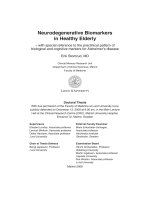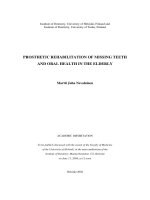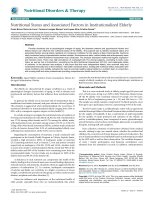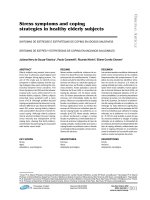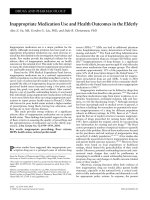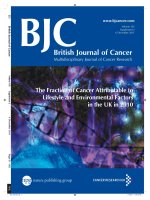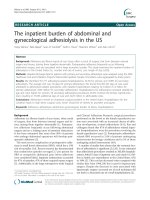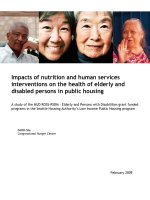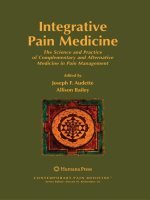Nutritional Status and Associated Factors in Institutionalized Elderly docx
Bạn đang xem bản rút gọn của tài liệu. Xem và tải ngay bản đầy đủ của tài liệu tại đây (951.64 KB, 5 trang )
Volume 2 • Issue 3 • 1000116
J Nutr Disorders Ther
ISSN: 2161-0509 JNDT, an open access journal
Nutritional Disorders & Therapy
de Lima et al., J Nutr Disorders Ther 2012, 2:3
/>Research Article Open Access
Nutritional Status and Associated Factors in Institutionalized Elderly
Costa Bruna Vieira de Lima
1
, Fonseca Leorges Moraes
2
and Lopes Aline Cristine Souza
3
*
1
Nutricionista Ph.D. in Nursing and Health School of Nursing, Federal University of Minas Gerais (UFMG) and Research Group in Nutrition Interventions – GIN, Brazil
2
Professor, Department of Technology and Inspection of Animal Products, School of Veterinary Medicine, Brazil
3
Department of Maternal-Child Nursing and Public Health - Nursing School - UFMG, Research Group in Nutrition Interventions - GIN, Centre for Urban Health and Center
for Studies in Public Health and Aging – NESPE, Brazil
Abstract
Peculiar situations due to physiological changes of aging, the diseases present and psychosocial factors and
dietary factors can inuence the nutritional status of the elderly. The purpose was to identify nutritional status and
associated factors among elderly residents of a long-term institution for the elderly in Belo Horizonte-MG. Sectional
study conducted using a representative random sample. Socioeconomic data, nutrient intake and anthropometry were
collected and a Mini Nutritional Assessment was conducted. The analysis employed multinomial logistic regression
and decision trees. There was high prevalence of overweight (46.1%) among subjects, according to body mass
index, as well as risk of malnutrition, according to the Mini Nutritional Assessment (67.3%), and inadequate intake
of nutrients. In the decision tree analysis, it was found that the more independent elderly, who received visits and
contributed nancially less to the institution, had better nutritional status. Inadequate nutritional status associated with
social conditions and mobility indicates the need to promote healthy eating habits by a nutrition team in conjunction
with nursing staff and other professionals providing comprehensive health care for the elderly.
*Corresponding author: Aline Cristine Souza Lopes, School of Nursing,
Department of Maternal-Child Nursing and Public Health, Avenida Alfredo
Balena 190, 4th Floor, Room 420, Santa Iphigenia, CEP 30130-100, Belo
Horizonte, Minas Gerais, Brazil, Tel / fax: 31 3409-9179 / 3409-9860; E-mail:
Received April 10, 2012; Accepted June 26, 2012; Published June 28, 2012
Citation: de Lima CBV, Moraes FL, Cristine Souza LA (2012) Nutritional Status
and Associated Factors in Institutionalized Elderly. J Nutr Disorders Ther 2:116.
doi:10.4172/2161-0509.1000116
Copyright: © 2012 de Lima CBV, et al. This is an open-access article distributed
under the terms of the Creative Commons Attribution License, which permits
unrestricted use, distribution, and reproduction in any medium, provided the
original author and source are credited.
Keywords: Aged; Elderly nutrition; Food consumption; Homes for
the aged; Malnutrition; Obesity
Introduction
e elderly are characterized by unique conditions as a result of
physiological changes characteristic of aging, as well as diseases and
psychosocial and dietary factors that inuence their nutritional status
[1].
In general, the elderly are at increased risk of malnutrition due to
insucient food intake (amount) and poor selection of food (quality).
is situation is aggravated when institutionalized, the occurrence of
nutritional disorders in institutionalized elderly ranging from 30% to
80%, with a consequent negative impact on their health [2].
In a study aiming to investigate the nutritional status of residents of
ve long-stay institutions for the elderly (ILPI), the risk of malnutrition
was 37.5% among older females and 43.7% among the elderly males,
with malnutrition more prevalent among women (12.5% vs. 6.2%) [3].
Using a Mini Nutritional Assessment (MNA), another study conducted
in Rio de Janeiro showed that 8.3% of institutionalized elderly were
suering from malnutrition, while 55.6% were at risk [4].
Regarding the consumption of nutrients, a study conducted with
participants in the Family Health Program in Vitória, Espírito Santo,
revealed a high prevalence (80%) of inadequate intake of nutrients
[5]. Examining nutrients such as vitamin C, iron and protein revealed
respectively an inadequacy of 44.8%, 15.9% and 14.6%. Another study
to assess iron intake in institutionalized elderly, found that 98% of the
elderly males and 89% of the females were consuming more than the
recommended intake. Yet zinc intake was in adequate in 100% of the
elderly males and 98.5% of the females [6].
A deciency of such nutrients can compromise the health of the
elderly, leading to loss of muscle mass, poor wound healing, depression,
reduced memory and dementia, situations which are aggravated by the
presence of malnutrition [1]. In contrast, inadequate consumption
of calories and lipids can contribute to a higher occurrence of excess
weight, a condition also prevalent in this group, as well as cardiovascular
diseases, neoplasm and other disorders [1].
Given the inuence and importance of the nutritional health of
older people, especially those who are institutionalized, this article
examines the nutritional status and associated factors in a representative
sample of elderly residents of a long-term philanthropic institution in
Belo Horizonte, Minas Gerais.
Materials and Methods
is is a cross-sectional study of elderly people aged 60 years and
over, of both sexes, living in an ILPI in Belo Horizonte, Minas Gerais.
Of the 94 elderly were randomly selected 55 people over 60 years,
based on 99% of explanatory power (n = 35) and 30% loss (n = 55).
e sample was simply random, comprised of 52 elderly patients, since
three gave up to participate, however, representing 55.3% of the total.
e ILPI under study is a philanthropic entity with an agreement
with the Municipal Oce of Food and Nutrition Safety in Belo Horizonte
for the supply of foodstus. It has a nutritionist on sta responsible
for the quality of meals produced and nutrition of the elderly, as
well as a multidisciplinary team comprised of nurse, physiotherapist,
speech therapist, social worker, psychologist, pharmacist, occupational
therapist, nursing sta and caregivers.
Data collection consisted of information obtained from medical
records, relating to age, sex, marital status, whether the resident had
children, the occurrence of chronic diseases and level of education. e
use of dental prosthesis was established based on information provided
by the ILPI sta, as well as direct observation. e variables frequency
of visits / family participation and nancial contribution were
obtained from the institution’s records. In addition, anthropometric
Volume 2 • Issue 3 • 1000116
J Nutr Disorders Ther
ISSN: 2161-0509 JNDT, an open access journal
Citation: de Lima CBV, Moraes FL, Cristine Souza LA (2012) Nutritional Status and Associated Factors in Institutionalized Elderly. J Nutr Disorders
Ther 2:116. doi:10.4172/2161-0509.1000116
Page 2 of 5
measurements were collected, and information referring to the MNA
and three-day food record was collected.
For the anthropometric evaluation, the following variables were
used: Body mass index (BMI), calf (CP), arm (AC), waist (WC) and
Hip circumference (HC), Waist / hip ratio (WHR), Triceps skinfold
(TSF) and adjusted arm muscle area (AMBc). All measurements
were obtained in accordance with recommendations [7], and the
anthropometric variables were evaluated three times, and an average
obtained.
e height and weight of the elderly who showed postural
instability, or who were bedridden, was obtained from knee height and
an equation that combines anthropometric data, respectively [8].
e cut-o points adopted for adjusting BMI were those proposed
[9], while the WC and WHR values were compared with the cuto
set [7]. e estimation of AMBc was performed using the equations
proposed [10] and classied according to the percentiles [11].
e circumference of the calf was determined in accordance with
recommendations [12].
For the diagnosis of risk and malnutrition, particularly in the
elderly, the Mini Nutritional Assessment was also utilized [13].
For the assessment of food intake, we used the three day food
record, and direct observation on a weekend day. Information about
the time, composition, consistency and amount of food eaten at
every meal of the day was recorded. e composition of the meal was
recorded according to the menu before being served. e amounts were
recorded in household measures, at the moment when the kitchen sta
served portions of food in the dining room. Immediately following the
meal, the dierence between what had been served and what remained
was calculated in household measures, thus providing the intake. is
quantitative consumption was converted into grams according to a
chart of household measures. ese values were then converted into
calories and nutrients using DietWin® (DietWin Nutrition Soware)
and various food composition tables. Aer three days of recording, an
average caloric and nutritional intake was obtained, which was then
used in the study.
To calculate energy requirements, equations for Dietary
Reference Intakes (DRIs) as proposed [14]
were used. Macronutrient
recommendations were calculated in accordance with the percentage
distribution values based on the DRIs [14]. e recommendations for
fatty acids and cholesterol were based on proposals [7].
We performed a qualitative assessment of nutrient intake, which
was classied as insucient, adequate or excessive according to sex and
age. e probability (P) of adequate intake (quantitative assessment)
was also performed for the following nutrients: iron, zinc, niacin,
thiamin, vitamins B
6
and B
12
.
Statistical analysis consisted of descriptive analysis and chi-square
test, Fisher’s exact test and ANOVA to determine the factors associated
with nutritional status, assessed by BMI and MAN. In addition, we
used multinomial logistic regression analysis and the decision tree.
For entering predictor variables in the multinomial logistic model,
a signicance level of 25% was used. e variables were adjusted to the
model by the backward stepwise method, using a signicance level of
5%.
e decision tree was the second method of multivariate analysis
used to describe the factors that contributed to the occurrence of
nutritional disorders. is method is based on classication rules
based on a decision tree. e tree starts with a root node, with
all the observations in the sample, and the subsequent branches
represent subdivisions and subsets of data. is subdivision allows
the identication of homogeneous subgroups of individuals for the
systematic comparison of their characteristics. e division process is
repeated until none of the selected variables show signicant inuence
on the division or when the size of the subset is very small [15].
For all analyses, we adopted a 5% level of signicance using the
Statistical Package for Social Sciences, version 17.0.
is study was approved by the Research Ethics Committee of the
Federal University of Minas Gerais. All individuals signed a consent
form, and for those who were unable to write, a nger print was
obtained.
Results
Of the 55 seniors sampled, three declined to participate in the
survey, so that the nal sample included 52 elderly (94.5%), and 55.3%
of the total number of elderly who were institutionalized.
Demographic data revealed that the subjects had a mean age of 76.6
± 9.0 years: 82.7% were female, and 40.4% had no schooling. Of the
total, 46.2% were single, 40.4% had children, 57.7% rarely had visitors
and 84.6% contributed 70% of their income to the ILPI.
With regards to mobility, 23.1% were conned to bed or wheelchair,
while 55.8% had normal mobility. As for oral health, the use of dentures
was observed in 19.2% of subjects, partial denture in 32.7% and 38.5%
were edentulous without the use the dentures.
e mean and median number of comorbidities was 4, with a
minimum of one and maximum of seven diseases per person. e most
prevalent diseases and health problems were hypertension - (75.0%),
psychiatric disorders (53.8%) and osteoporosis / osteoarthritis (26.9%).
Table 1 shows the variables related to nutritional status. According
to BMI, the prevalence of overweight was 46.1% and underweight,
23.1%. On the other hand, the prevalence of malnutrition, according to
the MAN classication, was 7.7% and the risk of malnutrition of 67.3%.
n Percentage (%)
Body Mass Index - -
Underweight 12 23,1
Overweight 24 46,1
Mini Nutrition Assessmet - -
Risk for malnutrition 36 67,3
Malnutrition 4 7,7
Calf circumference - -
Muscle loss 11 21,2
Arm Muscle Area - -
Severe muscle decit 11 21,2
Decit mild muscle 7 13,5
Normal muscle 30 57,7
Excess muscle 2 3,8
Muscle increased 2 3,8
Waist circumference* - -
Very high risk of complications associated with obesity 21 56,8
High risk of complications associated with obesity 4 10,8
Waist/Hip ratio* - -
Risk of cardiovascular disease 26 70,3
*15 individuals without information (wheelchair)
Table 1: Nutritional status and risk for metabolic diseases of the elderly of the
institution.
Volume 2 • Issue 3 • 1000116
J Nutr Disorders Ther
ISSN: 2161-0509 JNDT, an open access journal
Citation: de Lima CBV, Moraes FL, Cristine Souza LA (2012) Nutritional Status and Associated Factors in Institutionalized Elderly. J Nutr Disorders
Ther 2:116. doi:10.4172/2161-0509.1000116
Page 3 of 5
unable to walk outside the ILPI and older than 78.5 years, the risk
of malnutrition was 66.7% and the prevalence of malnutrition of
16.7%. In this situation, when nancial contribution was taken into
consideration, 21.4% of seniors who contributed 70% of their income
had good nutritional status, while 71.4% were at risk of malnutrition.
However, when this contribution rose to 100% of retirement income,
this situation was reversed, rising to 50.0% of the elderly showing
malnutrition, while the remaining 50% were at risk of the disease
(Figure 2).
Discussion
In this study both a high prevalence of overweight (46.1%),
according to BMI, and risk of malnutrition (67.3%), according to
MAN, were veried, concomitant with reduced muscular reserve and
excess abdominal adiposity. e consumption of nutrients, although
insucient, especially for vitamins and minerals, was not associated
with nutritional status, or with socioeconomic data. On the other hand,
the mobility of the elderly, their nancial contribution to the ILPI and
frequency of visits were important factors in understanding their
nutritional status. is demonstrates the importance of promoting
care practices through health promotion with the elderly and families
to improve their nutrition and quality of life.
e prevalence of underweight and overweight according to
BMI was similar to that reported by other studies [16-17]. Similarly,
Loss of muscle mass was observed in 21.2% of subjects, according to
CP and AMBc. According to the CC classication, 59.4% of the seniors
were at risk of complications associated with obesity and 70.3%,
according to the WHR, were at risk of cardiovascular disease.
According to the dietary assessment (Table 2), 17.3% of the elderly
showed excessive caloric intake, while 11.5% had inadequate intake, the
average daily intake being 1,530.61 kcal, ranging from 993.80 to 2432.81
kcal. e consumption of fats, polyunsaturated and monounsaturated
fatty acids was shown to be inadequate in almost all individuals.
ere was a signicantly insucient intake of potassium (100%),
zinc (82.7%) and niacin (65.4%) in the study group. as well as excessive
consumption of vitamin B6 (84.6%) and B12 (51.9%). e probability
of adequate iron intake was 68.0% and that of zinc was 33.0%. With
regards to vitamins, the probability of adequate intake varied between
46% and 67%.
In the multinomial multivariate analysis, no variable was
statistically associated with nutritional status, whether measured by
BMI or by MAN (p>0.05).
In the decision tree analysis, with BMI as the response variable
(Figure 1), we found that all seniors, 65 years old or more having some
form of mobility restriction, and taking the frequency of visits into
consideration, were underweight. But for those with mobility problems,
older than 65 years and who rarely had visitors, the prevalence of
underweight decreased to 40%. On the other hand, for those elderly
receiving weekly, fortnightly or monthly visits, this percentage dropped
to 16.7% and for those with normal mobility to 10.3%.
However, among older people 91 years or less with normal
mobility, the prevalence of overweight subjects was high (62.1%), while
those with normal mobility and more than 91 years were all eutrophic
(Figure 1).
In the decision tree, with MAN as the response variable (Figure 2),
the younger patients (≤ 78.5 years) showed higher risk of malnutrition
(100%), while those older (> 78.5 years) were at lower risk (50%), yet
were more likely to be malnourished (50%). On the other hand, none
of the elderly aged less than 78 years and who had normal mobility or
able to stroll, but were unable to walk outside of the ILPI, displayed
malnutrition; however, 54.5% were at risk of malnutrition.
For the elderly with normal mobility or able to stroll, but were
Table 2: Qualitative and quantitative adequacy of micronutrient intake of the elderly
of the institution.
Consumption (%)
Probability (%)
Insufcient Suitable Excessive
Calories 11,5 71,2 17,3 -
Protein 5,8 94,2 0,0 -
Lipid 100,0 0,0 0,0 -
Saturated Fatty Acid 0,0 88,5 11,5 -
Monounsaturated Fatty
Acid
98,1 1,9 0,0 -
Polyunsaturated Fatty Acid 100,0 0,0 0,0 -
Cholesterol 0,0 100,0 0,0 -
Iron 13,5 71,2 15,4 68,0
Potassium 100,0 - - -
Zinc 82,7 11,5 5,8 33,0
Thiamine 23,1 26,9 50,0 51,0
Niacin 65,4 23,1 11,5 46,0
Vitamin B
6
5,8 9,6 84,6 67,0
Vitamin B
12
44,2 3,8 51,9 56,0
Figure 1: Decision tree (CART algorithm) with the response to nutritional
status measured by Body Mass Index.
Volume 2 • Issue 3 • 1000116
J Nutr Disorders Ther
ISSN: 2161-0509 JNDT, an open access journal
Citation: de Lima CBV, Moraes FL, Cristine Souza LA (2012) Nutritional Status and Associated Factors in Institutionalized Elderly. J Nutr Disorders
Ther 2:116. doi:10.4172/2161-0509.1000116
Page 4 of 5
prevalence of abdominal obesity as measured by WC and WHR [16]
was also reported. It is noteworthy that, independent of excess weight,
abdominal fat has an important impact on cardiovascular disease and
is oen associated with the occurrence of dyslipidemia, hypertension,
insulin resistance and diabetes, especially among the elderly [6-17].
Nutritional status, assessed using MAN, showed results similar
to those found another study
[4]
, where the prevalence of malnutrition
was 8.3% and that of risk, 55.6%. However, the study in the province
of Ourense, the risk of malnutrition was similar (57.5%), but the
prevalence of malnutrition slightly higher (12.5%) [18].
Corroborating the ndings related to nutritional status, the elderly
showed considerable percentage of reduction in muscle mass, as
measured by CP and AMBc. is decline negatively impacts the health
of elderly people, especially for those who are institutionalized, and is
perhaps associated with the occurrence of diseases such as tuberculosis
and obstructive lung diseases. In addition, muscle weakness may
develop, preventing the elderly from performing daily activities such as
rising from a chair or carrying objects [19].
ere was high prevalence of overweight and high risk of diseases
associated with obesity and cardiovascular disease according to BMI,
WC and WHR. BMI is highly correlated with body weight and has
proximity to the body energy stores, without predicting the distribution
of fat corporal [1].
On the other hand, MAN which predicts about the risk of developing
malnutrition, showed a high rate of elderly at risk, pointing to the
need for nutrition interventions. In assessing the factors contained in
MAN, which contributed to the diagnosis of malnutrition risk in the
institutionalized elderly, Ruiz-Lopez and colleagues [20] found a high
proportion of risk of malnutrition related to factors related to lifestyle,
medication and mobility.
In multinomial logistic regression analysis found no model, possibly
because it was not able to detect dierences. erefore, we opted for
a second type of multivariate analysis, which is the Classication
and Regression Tree. is analysis is used to describe the factors that
contribute to the occurrence of tomographic changes. e adjustment
of the nal model was evaluated by estimating risk, which indicates the
extent to which the tree correctly predicts the results, comparing the
dierence between the adjusted value estimated by the model and the
actual value observed in the sample [21].
e nutritional status, as identied by BMI and MAN, proved to be
associated with mobility, frequency of visits and nancial contribution
by the elderly to the ILPI. e very old people with reduced mobility
and who received fewer visits had a higher prevalence of low weight,
possibly due to decreased access to food.
Elderly with mobility impairments have lower performance in
the ability to perform activities of daily living and greater dependence
on care, including meals and purchase of food [19]. e results of the
Health, Welfare and Aging in Latin America and the Caribbean Project,
which evaluated 2.143 elderly in São Paulo, revealed that the activities
most aected for both sexes was the ability to make unaccompanied
excursions outside of the home and shopping for foodstus [22]. us,
we can see the importance of the care provided by nursing sta, in
providing support in meeting mobility needs and principally those
related to eating, given the inuence on nutritional status.
On the other hand, the elderly who were more independent, who
received more frequent visits and contributed nancially less of their
income to the ILPI had better nutritional status, perhaps due to the fact
that they could complement their diet and consequently had access to
a better supply of nutrients.
e reduction of the prevalence of being underweight in the elderly
due to the frequency of visits or a lower contribution can be understood
to result from a possibly greater access of the elderly to foods that
complements the diet available from the ILPI. Aside from generating
positive emotions, visitors may also provide food, improving the
supply of calories and nutrients oered. is indicates the importance
of the participation of families in the social life of the elderly, because
social support has a positive inuence on their eating habits and health
status [23]. In addition, studies [24,25] show that having close friends
makes a positive impact on mental and physical health of the elderly.
Emphasized the importance of the multidisciplinary team as a source
of encouragement to build friendships, since this relationship is an
eective factor against loneliness, depression and immobility.
On the other hand, the lower nancial contribution to the ILPI
in terms of percentage of income favors purchase of complementary
foods by the elderly, given the greater availability of funds. However,
this condition may be compromised by mobility diculties that some
of the elderly may face.
It should be noted, however, that younger patients with preserved
mobility had a higher prevalence of overweight. It is noticed that on one
hand, greater access to food reduced the prevalence of underweight;
it also seemed to favor an increase in overweight. is reveals the
importance of promoting healthy dietary practices among those
who retain functional mobility, as well as among visitors, in order to
improve the adequacy of complementary feeding and to control food
intake by elderly people who have mobility diculties.
e need to adopt healthy eating practices can also be observed in
the analysis of nutrient intake. ere were insucient amounts of lipids,
monounsaturated and polyunsaturated fatty acids, zinc, potassium,
niacin and vitamin B
12
, as well as a signicant percentage of elderly
patients with caloric intake below or above recommended levels, which
Figure 2: Decision tree (CART algorithm) with a response to the classication
of Mini Nutritional Assessment.
Volume 2 • Issue 3 • 1000116
J Nutr Disorders Ther
ISSN: 2161-0509 JNDT, an open access journal
Citation: de Lima CBV, Moraes FL, Cristine Souza LA (2012) Nutritional Status and Associated Factors in Institutionalized Elderly. J Nutr Disorders
Ther 2:116. doi:10.4172/2161-0509.1000116
Page 5 of 5
can foster the emergence of new malnutrition and overweight cases,
respectively.
e high prevalence of dental impairment, also observed in other
studies [26], may have contributed to this low intake of nutrients
because it is known that edentulism and prosthetic rehabilitation
is associated with a decrease in the average intake of vitamins and
minerals [5].
is imbalance in nutrient intake can prejudice the health of the
elderly. e lipids in the diet are critical for the supply of energy, giving
avor to food, and the sensation of satiety, with consequent spacing
between meals, as well as transmitting lipo-soluble vitamins and
essential polyunsaturated fatty acids. However, the results of this study
showed an imbalance in the ratio of fatty acids, with a predominance of
saturated fat at the expense of monounsaturated and polyunsaturated
fats, which may favor the occurrence of dyslipidemia and cardiovascular
events, more common among the elderly [1].
Despite the signicant ndings, the study has no external inference
and presents a limitation to small sample size. It should be noted,
however, that the purpose of the study was to evaluate the reality of ILPI
and compare it with the literature, to contribute toward knowledge in
the area and implementation of changes that favor the health of the
older people in question. For this, the identication of the importance
of other issues, such as social, for the nutritional status of elderly people
living in an ILPI, justies this study, as well as others on this issue.
Conclusion
Given the vulnerability of the group added with changes in body
composition that occur with aging highlight the importance of the
classication of nutritional status based on BMI and MAN.
Continuing education must be applied with the aim of training
professionals to meet the basic needs of the elderly, especially those
related to mobility and feed.
e results also point to the need to promote healthy eating habits
within the ILPI in order to increase the proportion of elderly patients
with adequate nutritional status. For this, the active participation of
the dietician and nursing sta, together with other professionals in the
institution is essential in order to provide a healthy diet with adequate
intake of nutrients specic to the elderly, as well as an appropriate focus
on the social issues involved.
References
1. Silveira EA, Lopes ACS, Caiaffa WT (2007) Avaliação do Estado Nutricional de
Idosos. In: KAC G, SICHIERI, R, GIGANTE DP Epidemiologia Nutricional. Rio
de Janeiro: Atheneu Cap 6:105-125.
2. Alibhai SM, Greenwood, C, Payette H (2005) An approach to the management
of unintentional weight loss in elderly people. CMAJ 172: 773-80.
3. Santelle O, Lefevre AMC, Cevato AM (2007) Alimentação institucionalizada
e suas representações sociais entre moradores de instituições de longa
permanência para idosos em São Paulo, Brasil. Cad Saude Publica 23: 3061-
3065.
4. Machado RSP, Coelho MASC (2011) Risk of malnutrition among Brazilian
institutionalized elderly: A study wtih the Mini Nutritional Assessment (MNA)
questionnaire. J Nutr Health Agin 15: 532-535.
5. de Andrade FB, Caldas Junior Ade F, Kitoko PM, Zandonade E (2011) The
relationship between nutrient intake, dental status and family cohesion among
older Brazilians. Cad Saude Publica 27: 113-122.
6. Villarino Rodríguez A, García-Linares MC, García-Fernández MC, García-
Arias MT (2003) Evaluación dietética y parámetros bioquímicos de minerales
en uncolectivo de ancianos de la provincia de León (España). Nutr Hosp18:
39-45.
7. World Health Organization. (1998) Obesity: preventing and managing the
global epidemic. Geneva: World Health Organization.
8. Chumlea WMC, Roche AF, Steinbaugh ML (1989) Anthropometric approaches
to the nutritional assessment of the elderly. In: MUNRO, H.; DANFORD, D. E.
Human Nutrition: Nutrition Aging and The Elderly. New York: Plenum Press,
1989, Cap 6: 335-361.
9. Greer, Margolis, Mitchell (1992) Nutrition interventions manual for professionals
caring for older Americans. Grunwald & Associates, Washington, DC, 1-130.
10. Heymseld SB, Mcmanus C, Smith, J, et al. (1982) Anthropometric
measurement of muscle mass: revised equations for calculating bonefree arm
muscle area. American Journal of Clinical Nutrition 36:680-690.
11. Frisancho AR (1993) Anthropometric Standers for the Assessment of Growth
and Nutritional Status. 4 ed Michigan: Ann Arbor.
12. World Health Organization (1995) Physical status: the use and interpretation of
anthropometry. Report of a WHO Expert Committee. World Health Organ Tech
Rep Ser 854: 1-452.
13. Guigoz Y, Vellas B, Garry PJ (1994) Mini Nutritional Assessment: a pratical
assessment tool for granding nutritional state of elderly patients. Facts and
Research in Gerontology 4: 15-59.
14. Institute of Medicine. Dietary Reference Intakes for Energy, Carbohydrate,
Fiber, Fat, Fatty Acids, Cholesterol, Protein, and Amino Acids. Washington,
DC: National Academy Press. 2002.
15. Breiman L, Friedman JH, Olshen RA, Stone CJ (1984) Classication and
regression trees. Pacic Grove, Califórnia: Wadsworth and Brooks.
16. Santos MRDR, Mendes SCSM, Morais DB, Coimbra MPS, Araújo MAM, et
al.(2007) Caracterização nutricional de idosos com hipertensão arterial em
Teresina, PI. Revista Brasileira de Geriatria e Gerontologia10: 73-86.
17. Tinoco ALA, Brito LF, Santanna MSL, Abreu WC, Mello AC, et al. (2006)
Sobrepeso e obesidade medidos pelo índice de massa corporal (IMC),
circunferência da cintura (CC) e relação cintura/quadril (RCQ), de idosos
de um município da Zona da Mata Mineira. Revista Brasileira de Geriatra e
Gerontologia 9: 63-73.
18. Miguelez, JM, Salve CA, Bernardez MM (2009) Evaluación del riesgo
nutricional mediante el MNA en una población anciana no institucionalizada.
Archivos Latinoamericanos de Nutrición 59: 390-395.
19. Gonçalves LHT, Silva AH, Mazo GZ, Benedetti TRB, Santos SMA, et al. (2010)
O idoso institucionalizado: avaliação da capacidade funcional e aptidão física.
Caderno Saúde Pública 26: 1738-1746.
20. Ruiz-López MD, Artacho R, Oliva P, Moreno-Torres R, Bolanos J, et al.
(2003) Nutritional risk in institutionalized older women determined by the mini
nutritional assessment test: what are the main factors? Nutrition 19: 767-771.
21. Breiman L, Friedman JH, Olshen RA, Stone C (1984) Classication and
Regression Trees. Pacic Grove, Califórnia: Wadsworth and Brooks.
22. Duarte YAO, Lebrão ML, Lima FD (2005) Contribuição dos arranjos
domiciliares para o suprimento de demandas assistenciais dos idosos
com comprometimento funcional em São Paulo, Brasil. Rev Panam Salud
Publica17:370-378.
23. Salgueiro H, Lopes M (2010) A dinâmica da família que coabita e cuida de um
idoso dependente. Rev Gaucha Enferm 31: 26-32.
24. Llobet MP, Ávila NR, Farrás JF, Canut ML, et al. (2011) Qualidade de vida,
felicidade e satisfação com a vida em anciãos com 75 anos ou mais, atendidos
num programa de atenção domiciliária. Rev Latino-Am 19: 467-475.
25. Aday R, Kehoe G, Farney L (2006) Impact of Senior Center Friendships on
Aging Women Who Live Alone. J Women Aging 18: 57- 73.
26. Roque FP, Bomm FMS, Chiari BM (2010) Descrição da dinâmica de
alimentação de idosas institucionalizadas. Rev Soc Bras Fonoaudiol 2010 15:
256-263.
